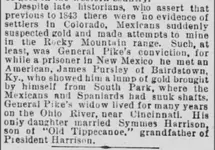ECS
Banned
- Joined
- Mar 26, 2012
- Messages
- 11,638
- Reaction score
- 17,695
- Golden Thread
- 0
- Location
- Ocala,Florida
- Primary Interest:
- Other
With the total lack of direct evidence that can confirm Beale's grand adventure and the others events of the story, what remains is a fictional novel created from the imagination of the author(s).But the evidence we have shows it to be possible. Now do you understand what I've been saying?
The rest of your post can be applied to your claim of dime novel. No proof.
Simple logical deduction due to the absence of outside documentation.







